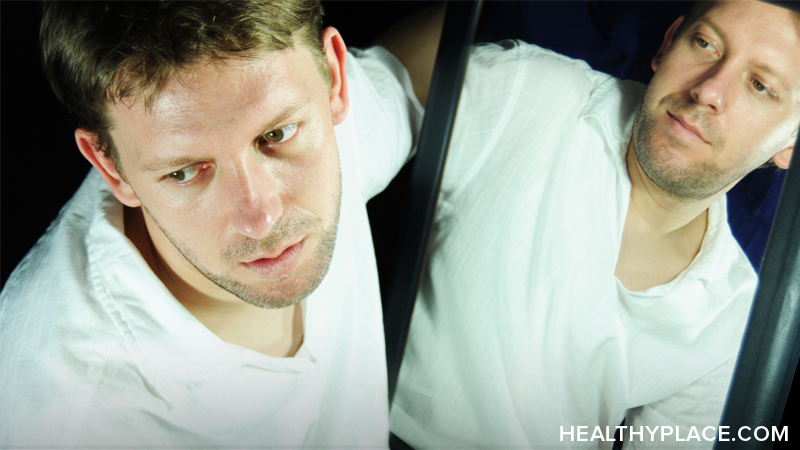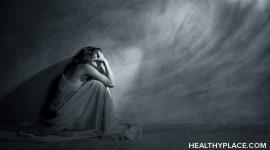What Is Bipolar II Disorder? Definition, Symptoms, Treatment

Bipolar II disorder (also known as bipolar disorder type II or bipolar disorder type 2) is a type of bipolar disorder with elevated or irritable moods that differ from those found in bipolar disorder type I (see "What Is the Difference Between Bipolar I and Bipolar II?"). Bipolar disorder type II has a slightly greater prevalence. While approximately one percent of people in the United States will develop bipolar disorder type I in their lifetime, approximately 1.1 percent of people will develop bipolar disorder type II. Some researchers have found these rates to be climbing in recent years, however. More women than men experience bipolar disorder type II.
Bipolar disorder type II is characterized by severe mood episodes, both of an elevated or irritated nature and of a depressed nature. These elevated or irritable moods are called “manias” or “manic moods” in bipolar disorder type I and “hypomanias” or “hypomanic moods” in bipolar disorder type II with “hypomania” literally meaning “less than mania.” Some people would call bipolar disorder type II “soft” bipolar disorder as it contains these less severe “hypomanias.” It should not be inferred, however, that one case of bipolar disorder is less severe than another, overall, simply by its type. There are severe cases of bipolar disorder type I and bipolar disorder type II; it varies by individual.
When a person experiences a specific bipolar mood that meets the diagnostic criteria discussed below, it is known as an “episode.” A person typically experiences three or fewer episodes per year. Episodes can last from days to months if left untreated. Note that some people experience more than three episodes per year and this is known as rapid cycling.
Bipolar II Disorder DSM-5 Criteria
To be diagnosed with bipolar disorder type II, the person must have experienced at least one period of hypomania and at least one period of depression as defined in the Diagnostic and Statistical Manual of Mental Disorders, Fifth Edition (DSM-5). If the person experiences mania, that person qualifies for the bipolar disorder type I diagnosis rather than the bipolar disorder type II diagnosis.
According to Medscape, the DSM-5 defines hypomanic episodes as being an elevated, expansive (unrestrained emotional expression, often accompanied with an overvaluation of one’s importance or significance to others) or irritable mood of at least four consecutive days in duration that also includes at least three of the following symptoms:
- Grandiosity (an exaggerated belief in one’s importance) or inflated self-esteem
- Diminished need for sleep
- Pressured speech
- Racing thoughts or flight of ideas
- Clear evidence of distractibility
- Increased level of goal-focused activity at home, at work or sexually
- Engaging in activities with a high potential for painful consequences
Other people must be able to observe the mood disturbance the mood can’t be as a result of substance abuse or a medical condition. Hypomanias are not severe enough to cause social or occupational impairment and do not contain psychosis.
According to Medscape, the DSM-5 defines depressive episodes (depressions; major depressions) as, for the same two weeks, experiencing five or more of the following symptoms, with at least one of the symptoms being either a depressed mood or characterized by a loss of pleasure or interest:
- Depressed mood
- Markedly diminished pleasure or interest in nearly all activities (also known as anhedonia)
- Significant weight loss or gain or significant loss or increase in appetite
- Hypersomnia or insomnia (too much or too little sleep)
- Psychomotor retardation or agitation (physical and psychological slowing or restlessness)
- Loss of energy or fatigue
- Feelings of worthlessness or excessive guilt
- Decreased concentration ability or marked indecisiveness
- Preoccupation with death or suicide; the patient has a plan or has attempted suicide
These symptoms must cause significant impairment and distress and must not be the result of substance abuse or a medical condition. The criteria for depressions in bipolar type II are the same as those in bipolar type I.
DSM-5 Bipolar Disorder Type II Specifiers
While hypomanias and depressions are the two required moods for a bipolar disorder type II diagnosis, either mood can actually have additional common features and thus can be further defined by a specifier. Specifiers can be used with either mood type. So, for example, a person could experience a depressed mood with anxious distress or a hypomanic mood with anxious distress.
The available specifiers are:
- With mixed features – when the diagnosed mood (either depression or hypomania) presents with symptoms of its opposite mood (this is often just termed a “mixed mood”)
- With anxious distress – when the mood episode occurs with symptoms of anxiety
- With rapid cycling – when four or more distinct mood episodes (of any type) occur within one year
- With psychotic features – when the mood episode occurs with the symptoms of psychosis (the presence of delusions and/or hallucinations; delusions are false beliefs held in spite of evidence to the contrary; hallucinations are false experiences involving any sense); psychotic features can occur in bipolar type II depression but not hypomania
- With catatonia – when the mood episode occurs with a syndrome characterized by muscular rigidity and mental stupor, sometimes alternating with great excitement and confusion
- Peripartum onset (also known as postpartum onset) – when the mood episode occurs during pregnancy up to four weeks after delivery
- Seasonal pattern – when the onset and remission of major depressive episodes are at specific times of the year
- With atypical features – when the depression occurs with a specific combination of features such as oversleeping, a heavy feeling in the arms or legs and mood that improves in reaction to positive events
- With melancholic features – when the depression occurs with specific depression features such as a lack a reactivity to positive events, significant anorexia or weight loss or depression that’s regularly worse in the morning
Bipolar Disorder Type II Treatment
When a person enters treatment for bipolar disorder type II, an evaluation is done, most importantly, to determine if the person is a danger to themselves or others or in a dangerously unstable state. Examples of this would be if the person is suicidal, homicidal or catatonic. Hypomanias do not typically require hospitalization but severe depressions may.
If a person has a dangerous condition or is unstable, the person will typically require inpatient treatment. Sometimes outpatient treatment is possible even with more severe bipolar symptoms when home support is significant. Day treatment or partial hospitalization where the person lives at home but receives multiple hours per day of treatment is also an option. If no imminent danger or major instability is present, the person can likely be treated on an outpatient basis.
Treatments generally used in bipolar disorder type II include:
- Medication therapy
- Psychotherapy
- Electroconvulsive therapy
- Lifestyle changes
Medication therapy in bipolar disorder type II is similar to that of bipolar disorder type I. The type of medication chosen will depend on the type of mood episode the person is in at the time. For example, if the person is in a depressed episode, the doctor might prescribe an antipsychotic, an anticonvulsant or a mood stabilizer. (Note that “antipsychotics” are not strictly used for psychosis treatment and “antipsychotic” is simply the drug class name.) Hypomania currently has no Food and Drug Administration (FDA)-approved medication treatments. Instead, doctors generally use treatments that have been approved for mania in the treatment of hypomania.
The following is a list of FDA-approved medications for use in bipolar disorder and the episode type for which they are approved (brand names in brackets):
- Aripiprazole (Abilify) – For use in mania, mixed episodes and bipolar maintenance.
- Asenapine (Saphris) – For used in mania and mixed episodes.
- Carbamazepine Extended Release (Equetro) – For use in mania and mixed episodes.
- Cariprazine (Vraylar) – For use in mania and mixed episodes.
- Chlorpromazine (Thorazine) – For use in mania.
- Lamotrigine (Lamictal) – For use in bipolar maintenance.
- Lithium – For use in mania and bipolar maintenance.
- Lurasidone (Latuda) – For use in depression.
- Olanzapine (Zyprexa) – For use in mania, mixed episodes and bipolar maintenance.
- Olanzapine/fluoxetine combination (Symbyax) – For use in depression.
- Quetiapine (Seroquel) – For use in mania and depression.
- Risperidone (Risperdal) – For use in mania and mixed episodes.
- Valproate (Depakote) – For use in mania.
- Ziprasidone (Geodon) – For use in mania and mixed episodes.
While the above are FDA-approved medications, it is common people with bipolar disorder type II to need multiple medications (polypharmacy) to remain stable. Other medications may also be used at a doctor’s discretion.
There are several types of psychotherapy that have been proven to be useful when treating bipolar disorder type II. They include:
- Prodrome detection therapy – includes education about the early warning signs of a bipolar mood episode and what to do about them
- Psychoeducation – includes learning about mental illness and bipolar, specifically
- Cognitive therapy – includes several components including identifying dysfunctional beliefs and medication adherence
- Interpersonal/social rhythm therapy – includes understanding the importance of routine in daily life
- Family-focused therapy – includes components of the above therapies but involves all members of the family as well
Electroconvulsive therapy (ECT) can also be used to treat bipolar disorder type II. Electroconvulsive therapy involves running a current of electricity through the brain, causing a seizure, while the person in under general anesthesia.
The following situations are ones in which this treatment type might be chosen:
- When rapid treatment is required due to the immediate dangers the illness poses to the person (such as in acute suicidality or in the case of food refusal)
- When the risks of ECT are less than that of other treatments (such as may be in the case where the person is pregnant)
- When other treatments have been tried and failed
- When the person with bipolar disorder chooses this treatment type
Electroconvulsive therapy is also attractive when the person has previously had it and experienced a positive response.
Changing one’s lifestyle can also make a very positive change to bipolar disorder type II symptoms. Some of these changes are covered in therapies like family-focused therapy and interpersonal/social rhythm therapy. These lifestyle changes might include:
- Adding an omega-3 supplement to the diet – this has been shown to help with bipolar depression symptoms
- Adding an exercise routine
- Creating a daily routine, particularly in regards to waking up and going to bed at the same time every day
- Ceasing all alcohol and drug use
Bipolar Disorder Type II Prognosis
Those with bipolar disorder can have repeated relapses throughout the lifespan. This can even happen when on medication as for many, medications do stop working and have to be evaluated at one or more points. Nonetheless, those who stay on medication do have the brightest prognosis. Psychotherapy and social support also improve the prognosis of those with bipolar disorder.
While the initial diagnosis of bipolar disorder type II can be very scary, learning about bipolar disorder, working with qualified mental health professionals and staying adherent to treatment can make managing the illness quite possible.
APA Reference
Tracy, N.
(2021, December 28). What Is Bipolar II Disorder? Definition, Symptoms, Treatment, HealthyPlace. Retrieved
on 2025, December 26 from https://www.healthyplace.com/bipolar-disorder/bipolar-types/what-is-bipolar-ii-disorder-definition-symptoms-treatment


